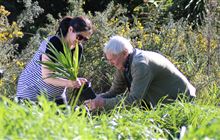Convention on Biological Diversity (CBD)
Introduction
The CBD promotes the development of global targets, national strategies and action plans for the conservation and sustainable use of biodiversity.The 1992 Earth Summit in Rio de Janeiro adopted the United Nations Convention on Biological Diversity (CBD).
The agreement covers biodiversity at all levels: ecosystems, species, and the use of their genes.
With 196 Parties, the CBD has participation from nearly every country.
For the first time in international law, it recognised that conserving biodiversity is a common concern of humankind.
The CBD has three main objectives:
- Conservation of biological diversity – also known as biodiversity
- Sustainable use of its components
- Fair and equitable sharing of benefits arising from genetic resources.
Convention on Biodiversity Diversity
Global biodiversity goals
The CBD sets global priorities for biodiversity conservation and sustainable use. Together, countries agree on and contribute to these priorities.
In December 2022, the CBD adopted the Kunming-Montreal Global Biodiversity Framework (GBF). The Framework sets a pathway to:
- spur everyone into urgent action
- halt and reverse biodiversity loss
- put nature on a path to recovery by 2030.
The GBF is made up of 4 global 2050 goals and 23 global 2030 targets. The targets are action oriented. Together, they aim to drive conservation action over the next decade, to halt and reverse the loss of biodiversity.
Kunming-Montreal Global Biodiversity Framework
New Zealand’s national biodiversity strategy
As a party to CBD, New Zealand is required to have a National Biodiversity Strategy and Action Plan (NBSAP). This strategy sets out our national contribution to reversing the loss of biodiversity worldwide.
DOC leads the development of New Zealand’s national biodiversity strategy and action plan, and reports on New Zealand’s progress towards it.
In 2020, the New Zealand Government launched Te Mana o te Taiao – Aotearoa New Zealand Biodiversity Strategy 2020 (ANZBS). This is New Zealand’s national biodiversity strategy and has been submitted to the CBD.
The strategy sets out a strategic framework for the protection, restoration and sustainable use of biodiversity in New Zealand. It covers the period from 2020 to 2050 and focuses on indigenous biodiversity.
Te Mana o te Taiao – Aotearoa New Zealand Biodiversity Strategy 2020
New Zealand’s national reporting to the CBD
Countries that are parties to the CBD must report their progress on their national strategy and action plan. Countries have agreed to national monitoring, reporting and review requirements, including through regular national reporting against a common set of global biodiversity indicators.
Monitoring Framework for the Kunming-Montreal Global Biodiversity Framework
New Zealand is required to report to the CBD on its implementation of the ANZBS. This includes:
- reporting on our progress against the objectives and goals in our national strategy and action plans, using national indicators
- reporting on how our efforts are contributing to the global biodiversity goals and targets, using the GBF’s monitoring framework.
You can find New Zealand’s most recent national report on the CBD website, or at the link below:
New Zealand will use the Outcome Monitoring Framework for biodiversity (OMF), developed by central and regional government, to monitor and report on our outcomes.
Read New Zealand’s response to the The Global Biodiversity Framework

